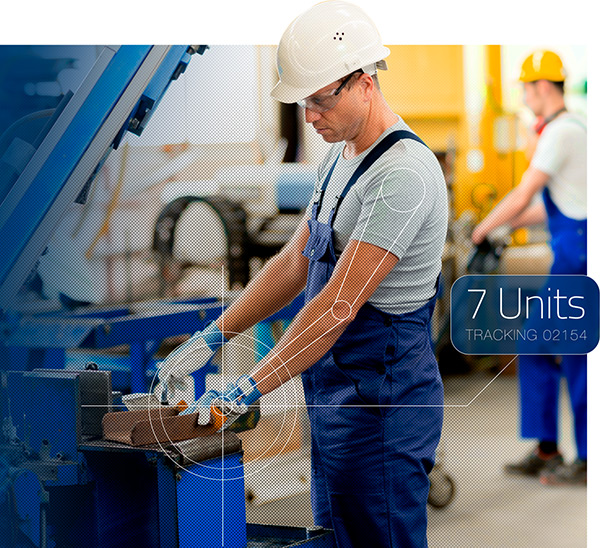24/7 continuous monitoring systems can detect and alert workers of accidents before they happen, helping manufacturers save untold dollars.
During the 20th century, the number of fatal accidents and serious injuries significantly decreased in almost every profession. According to the Economic History Association (EHA), some of it was attributed to a decrease in dangerous jobs, as well as technological innovations that made everyday tasks less risky for employees.
Prior to the 20th century, workplace accidents were significantly more common, but relatively inexpensive from the employer’s standpoint since it was more difficult for an injured worker to sue a company for damages. For example, in 1900 the EHA reported that about half of all fatally injured workers received compensation averaging only around half of their yearly income.
In 2020, according to the National Safety Council, each workplace-related injury compensation averaged around $44,000, whereas fatal injuries were about $1.3 billion each. That year, the total cost of work injuries equaled $163.9 billion. This number included lost wages, productivity, medical costs, administrative expenses, time spent recovering, and company property damage costs.
Increasing worker safety has become a huge priority to the workplace, and therefore a huge economic incentive to the employer, possibly saving them tens of thousands of dollars each time an injury occurs due to the rapid increase in costs. As a result, spending on safer equipment became a top priority for companies half a century ago and still continues to this day.
Nearly every profession has adopted this principle of prioritizing safety, especially fields that yield higher risks for employees, such as construction and manufacturing. In return, there has been a significant decrease in the amount of workplace fatalities. In 1928, almost 20,000 workplace fatalities were reported in the U.S. In 2020, although the nation’s population had tripled since, workplace fatalities totaled 4,113, including 340 in manufacturing.

Because manufacturing involves physical labor and repetitive work, it is easier for employers to detect safety risks to their employees. Over time, the evolving knowledge of workplace risks and best practices in manufacturing has helped organizations develop programs and tools to reduce the amount of work-related injuries. Many of these programs are reactive and created to offer some level of safety in the event a dangerous circumstance occurs. However, a proactive approach is imperative to prevent these unfortunate situations from happening in the first place.
Luckily, new innovations in manufacturing technology have allowed artificial intelligence to use continuous monitoring of work activity to detect a potential accident before it occurs. AI can now analyze videos filmed by cameras all around the factory floor to detect potential employee safety violations and proactively warn the worker of the danger. For example, if the camera spots an employee wearing the wrong protection equipment or positioned too close to a hazardous vehicle, it will contextualize this data and alert the company so they are aware of the safety hazard.
Although implementing AI monitoring systems can significantly reduce safety risks in the workplace and seems like an easy fix, a company plan of action is necessary before integrating these technologies. Manufacturing managers will need to make sure they choose a system integrator that is aligned with their company’s goals, and understand how to properly implement it throughout the organization so it will yield useful data.
Manufacturing floor procedures may have plenty of commonalities, but every operation will have its own unique weaknesses to improve on. About 75% of supply chain executives underestimate the time and cost it takes to integrate these solutions, according to McKinsey. Successful managers should not shy away from identifying blind spots on their floor and creating a solution that will increase worker safety and productivity.
If implemented, organizations must carefully select and continuously update its AI system integrator. Managing the switch to AI will require employees to be well-trained on new operating procedures and best practices. This is the biggest obstacle to adoption for businesses, according to an O’Reilly survey.
Over the last century, evolving knowledge of best practices in the manufacturing industry and the technological innovations of AI have proven to be a promising solution for increasing workplace safety, and will be for years to come.

About the Author:
Rob Schoenthaler is the chief revenue officer of ThinkIQ, with 25 yrs in enterprise software, analytics, IIoT, strategy, SupplyChain & manufacturing. Rob enjoys helping customers adopt cutting edge software to become more competitive in their operations. Currently, that energy is focused on adoption of ThinkIQ’s platform for supply chains with greater resilience, efficiency, profitability and sustainability.
Rob is a high-energy leader with over twenty-five years of successful executive leadership, practice management, solutions innovation and business development experience in the Enterprise SaaS and professional services industries. Prior to joining the ThinkIQ team, Rob began Atollogy to revolutionize how companies manage operations by integrating the physical world with artificial intelligence.
In this episode, I sat down with Beejan Giga, Director | Partner and Caleb Emerson, Senior Results Manager at Carpedia International. We discussed the insights behind their recent Industry Today article, “Thinking Three Moves Ahead” and together we explored how manufacturers can plan more strategically, align with their suppliers, and build the operational discipline needed to support intentional, sustainable growth. It was a conversation packed with practical perspectives on navigating a fast-changing industry landscape.